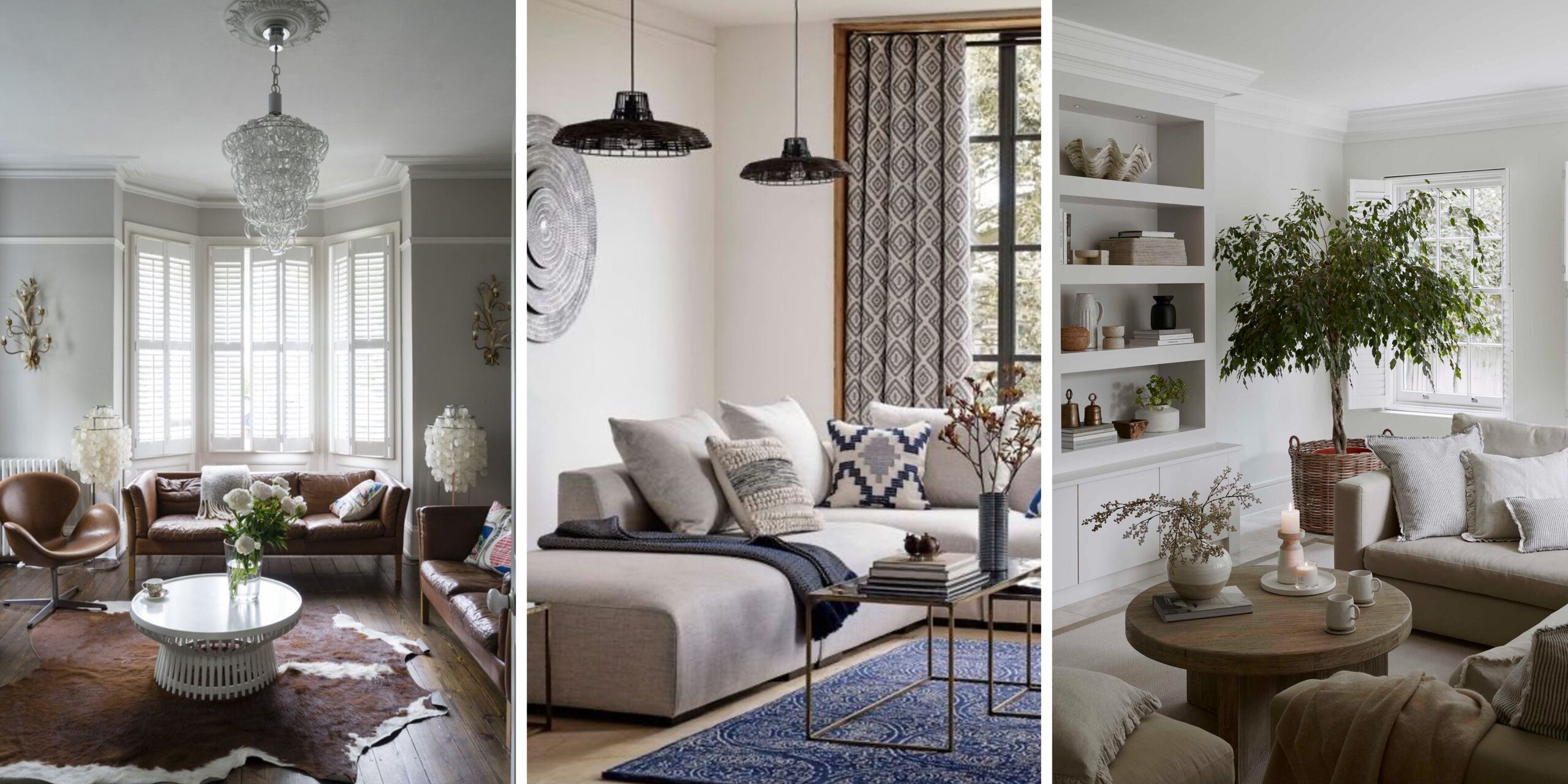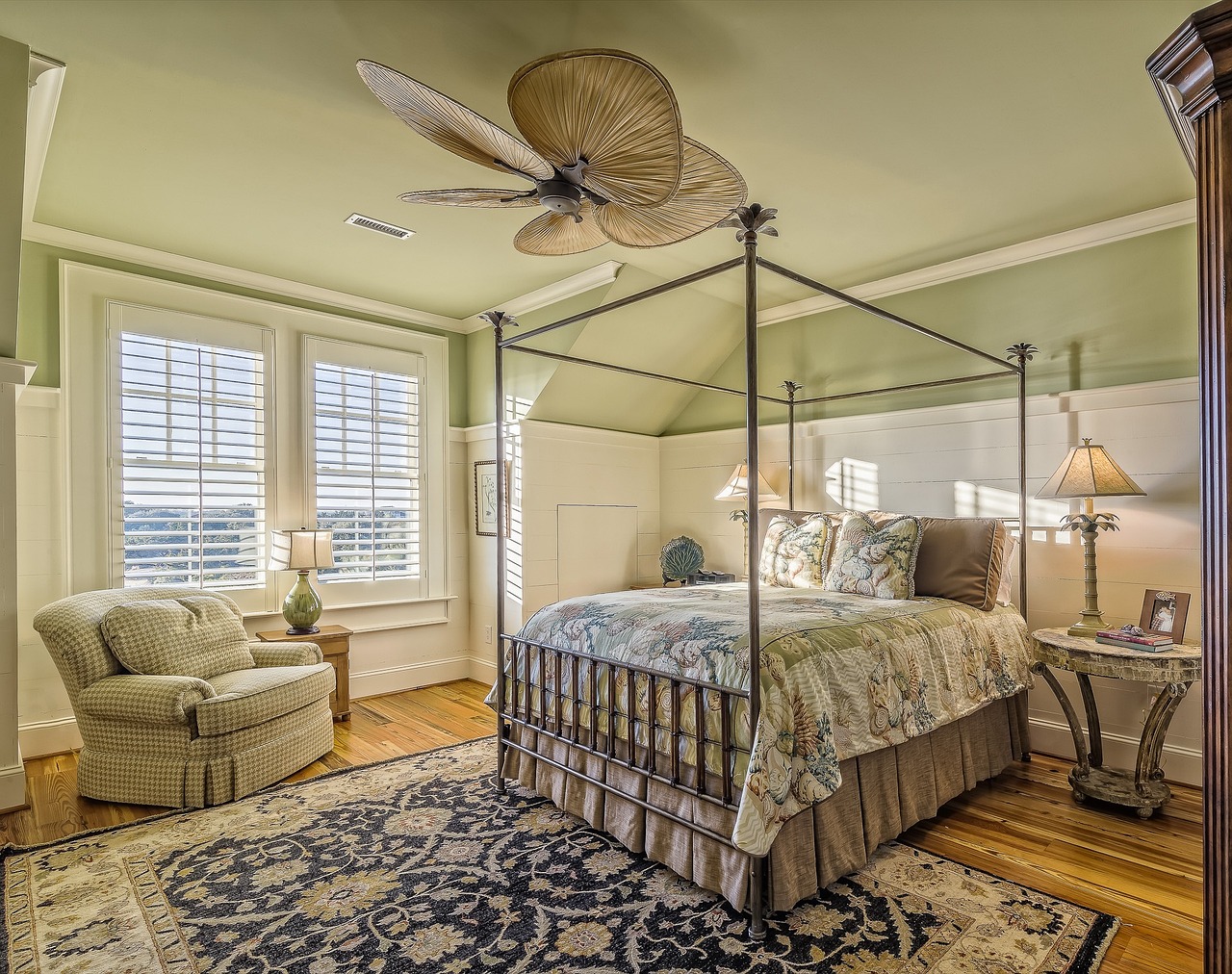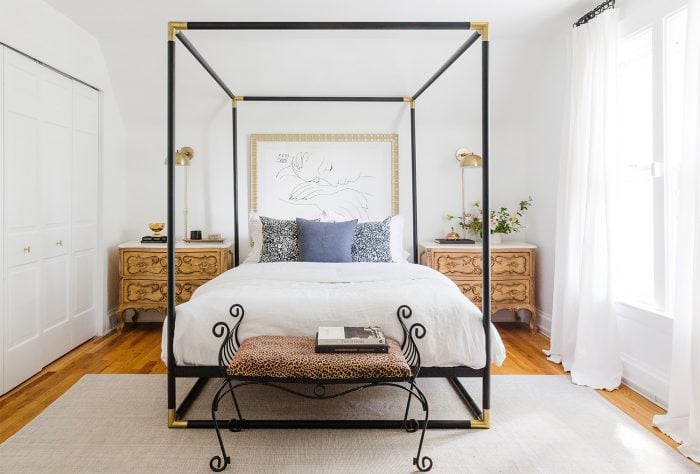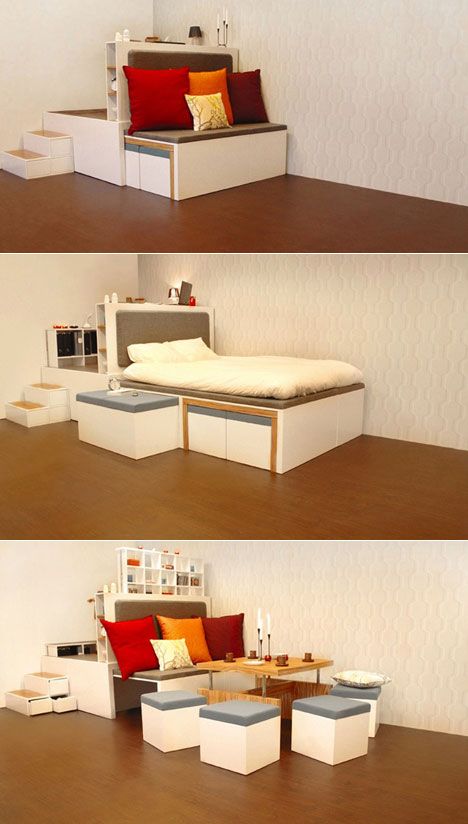Table of Contents
Designing a bedroom that caters to the preferences and needs of both partners in a relationship can be an exciting endeavor. It’s an opportunity to create a harmonious space that reflects the unique personalities and tastes of each person while fostering intimacy and relaxation. In this article, we’ll explore practical tips and creative ideas for designing a couples’ retreat that both you and your partner will love.
Creating a Couples’ Retreat: A Space for Love and Harmony
Designing a bedroom that serves as a haven for both partners in a relationship is not just about aesthetics; it’s about nurturing a bond and cultivating a sanctuary for intimacy and relaxation. This endeavor can be a thrilling journey, filled with opportunities to celebrate individuality while deepening the connection between you and your partner. Here, we’ll delve into practical advice and creative concepts for crafting a couples’ retreat that truly resonates with both of you:
Personalized Zones: Start by identifying each partner’s unique preferences and needs. Consider allocating specific zones or corners within the bedroom for personal expression. This might involve designating space for hobbies, whether it’s a reading nook for one and a mini art studio for the other. The key is to create room for individual pursuits while respecting shared areas as well.
Balanced Aesthetics: Finding a balance between your design preferences is essential. Blend your distinct styles harmoniously, incorporating colors, patterns and textures that reflect both your tastes. Embrace compromise and open communication to arrive at a decor that pleases both parties.
Symmetry and Cohesion: A bedroom with symmetry and cohesion can promote a sense of unity. Invest in matching or complementary furniture, bedding and decor elements that symbolize the togetherness of your relationship. These shared elements can serve as a visual reminder of your connection.
Intimate Lighting: Explore lighting options that enhance intimacy and relaxation. Consider installing dimmer switches or incorporating soft, warm-toned lighting fixtures. Candles and fairy lights can add a romantic touch, creating an ambiance conducive to intimate moments.
Bedroom Technology: Be mindful of technology in the bedroom. While some couples may enjoy watching movies together, the bedroom should remain a sanctuary free from work-related screens and distractions. Designate specific areas for TV or other gadgets if desired, but ensure they don’t encroach on the overall tranquility of the space.
Storage Solutions: Effective storage is vital for maintaining an organized and peaceful bedroom. Invest in storage solutions that cater to both partners’ needs. His-and-her closets or drawers can provide individual space, while shared storage can accommodate linens and common items.
Personal Artifacts: Display personal artifacts and memorabilia that hold sentimental value for both of you. This could include framed photographs, travel souvenirs or artwork that reminds you of special moments in your journey together. These items infuse your bedroom with love and nostalgia.
Intimate Seating: Incorporate intimate seating areas where you can connect on a deeper level. A cozy loveseat, a pair of comfortable chairs or even a window seat can become places for meaningful conversations, bonding or simply enjoying each other’s presence.
Bed Choices: The choice of a bed is crucial for a couple’s retreat. Invest in a comfortable mattress and bedding that suits both partners’ sleeping preferences. Consider size, firmness and any special features like adjustable bases for a restful night’s sleep.
Personal Retreat Rituals: Encourage personal retreat rituals that help you unwind and connect. This might involve reading together, practicing meditation or even sharing morning coffee in bed. These rituals can strengthen your bond and create cherished moments.
In essence, designing a couples’ retreat is an artful blend of your unique identities, a celebration of your shared journey and a commitment to nurturing your relationship. By thoughtfully combining your tastes and needs, you can create a harmonious, loving space where intimacy and relaxation flourish, turning your bedroom into a cherished sanctuary for both of you to enjoy.
Should you desire more in-depth information, it’s available for your perusal on this page: Suites Pocono Palace | Pocono Hotels
Start with a Shared Vision
The key to a successful couples’ bedroom design is communication. Begin by discussing your individual preferences, styles and must-haves. This open dialogue allows you to identify common ground and create a shared vision for the bedroom.
Creating a harmonious couples’ bedroom design is not just about aesthetics; it’s a reflection of your partnership and shared journey. Here’s an extended exploration of the importance of communication and collaboration in designing a bedroom that suits both partners:
Understanding Personal Preferences: Start by understanding each other’s personal preferences when it comes to bedroom decor. Discuss color palettes, furniture styles and design elements that resonate with each of you. This understanding forms the basis for compromise and collaboration.
Must-Haves and Deal-Breakers: Identify must-have elements and deal-breakers. These are aspects of the bedroom design that are non-negotiable for each partner. Knowing these upfront helps you prioritize and find creative solutions.
Creating a Mood Board: Consider creating a joint mood board or Pinterest board where you both can pin images that inspire you. This collaborative visual tool can help you see common themes and styles that you both appreciate.
Balancing Styles: If you have different design styles, find ways to blend them harmoniously. For example, if one partner prefers modern minimalism and the other loves vintage charm, explore how you can incorporate both styles through a mix of furniture and decor.
Color Scheme Consensus: Choose a color scheme together that appeals to both of you. Whether it’s a neutral palette with pops of color or a blend of your favorite hues, finding a color scheme that represents both partners can create a balanced look.
Personalized Decor: Incorporate personalized decor elements that celebrate your relationship. This could include framed photos, artwork or custom-made items that hold sentimental value.
Bedroom Functionality: Discuss the functionality of the bedroom. Consider factors like storage needs, workspace requirements and any additional functions you want the room to serve. Ensure that the layout accommodates these needs.
Quality Time Zones: Create zones within the bedroom that cater to different activities, such as a cozy reading nook, a work desk or a relaxation corner. Each partner can have their dedicated space for activities they enjoy.
Compromise and Flexibility: Be open to compromise and flexibility. You might need to let go of certain design elements or find creative ways to integrate them. The willingness to adapt and accommodate each other’s preferences is key.
Personal Retreats: Designate areas within the bedroom where each partner can have their own personal retreat. This ensures that there are spaces for solitude and relaxation when needed.
Trial and Error: Don’t be afraid to experiment with different design ideas. Try out various decor arrangements and be open to making adjustments based on what works best for both of you.
Seek Professional Guidance: If you find it challenging to reconcile your design preferences, consider consulting a professional interior designer. They can provide expert guidance and suggest solutions that bridge the gap between your styles.
Regular Check-Ins: As your relationship evolves, so can your bedroom design preferences. Schedule regular check-ins to discuss any updates or changes you’d like to make to the bedroom. This ensures that the space continues to reflect your partnership.
Celebrate Your Journey: Finally, use your bedroom design as an opportunity to celebrate your journey as a couple. Incorporate elements that remind you of your shared experiences, adventures and milestones.
Remember that designing a couples’ bedroom is a collaborative endeavor that can strengthen your bond and communication skills. It’s an opportunity to create a space that not only reflects your individual personalities but also symbolizes the beautiful union you share. By working together and embracing each other’s preferences, you can create a bedroom that truly feels like a shared sanctuary.
Should you desire more in-depth information, it’s available for your perusal on this page: Chapter 13. Orienting Ideas in Leadership | Section 4. Building …

Choose a Neutral Base
To accommodate varying tastes, start with a neutral color palette for the walls, flooring and large furniture pieces. Neutrals like soft grays, muted blues or warm beiges provide a versatile canvas that can easily be personalized with accents.
Starting with a neutral color palette for your bedroom is a strategic and versatile approach to interior design. It provides a clean and adaptable foundation that can be customized to suit a wide range of tastes and styles. Let’s explore this idea further and delve into the benefits and possibilities of beginning your bedroom design with neutrals:
1. A Timeless Canvas:
Neutral colors, such as soft grays, muted blues and warm beiges, are timeless and enduring. They don’t go out of style, making them an excellent choice for the long-term design of your bedroom. Neutrals create a backdrop that can seamlessly transition as your preferences evolve.
2. Versatility and Flexibility:
A neutral color palette offers the flexibility to adapt your bedroom to different aesthetics and themes. Whether you prefer a minimalist, bohemian, traditional or eclectic style, neutrals serve as a versatile canvas that welcomes a wide range of accent colors and decor choices.
3. Personalized Accents:
Neutrals allow you to infuse your personality and style through accent pieces. By keeping the walls, flooring and large furniture neutral, you can easily swap out accessories, bedding and decor items to create fresh looks as often as you like. This adaptability caters to the changing seasons or your evolving design preferences.
4. Serene and Calming Atmosphere:
Neutral colors are renowned for their ability to create a serene and calming atmosphere in a bedroom. They evoke a sense of tranquility and relaxation, promoting a peaceful environment that’s conducive to restful sleep and unwinding after a long day.
5. Maximizing Natural Light:
Neutrals are excellent at maximizing natural light in your bedroom. Lighter neutral tones, in particular, reflect and amplify sunlight, making your space feel brighter and more open. This can help you wake up feeling refreshed and energized each morning.
6. Complementary to Various Textures:
Neutrals complement a wide array of textures and materials. Whether you love the softness of plush bedding, the rustic charm of wooden furniture or the sophistication of metallic accents, neutrals provide a harmonious backdrop that allows these elements to shine.
7. Easy Maintenance:
Neutrals are forgiving when it comes to maintenance and cleaning. Stains and wear-and-tear are less noticeable on neutral surfaces, making it easier to keep your bedroom looking pristine with minimal effort.
8. Fostering Creativity:
A neutral base can actually inspire creativity. Knowing that you have a versatile canvas to work with encourages you to experiment with different color palettes and decor styles. It’s an opportunity to express your creativity through ever-evolving design choices.
9. Budget-Friendly Transition:
If you enjoy updating your bedroom decor regularly, starting with neutrals can be budget-friendly. You can change the look and feel of your space without the need for major renovations, simply by switching out accessories and textiles.
10. Personalized Retreat:
Ultimately, a neutral bedroom serves as a personalized retreat where you have the creative freedom to curate an environment that speaks to your unique style and preferences. It’s a reflection of your personality and a sanctuary where you can find comfort and solace.
In summary, beginning your bedroom design with a neutral color palette is a practical and adaptable approach that empowers you to personalize your space over time. It creates a tranquil foundation that complements a wide range of decor styles and allows you to express your creativity through personalized accents. Your bedroom becomes a versatile and ever-evolving oasis where you can find both calm and inspiration.
Additionally, you can find further information on this topic by visiting this page: Bedroom design ideas for couples | Hammonds

Personalize with Accent Colors
Introduce accent colors that reflect each partner’s personality. For example, if one partner prefers bold reds and the other gravitates towards calming blues, use these colors in decorative pillows, throws or artwork to balance the space.
Introducing accent colors that reflect each partner’s personality is a thoughtful way to create a harmonious and balanced bedroom that feels like a true reflection of both individuals. Here’s how you can extend this idea and make it even more personalized:
Color Harmony: Start by discussing color preferences openly with your partner. Understand their favorite colors and the emotions they associate with them. Find common ground where your color preferences overlap or choose complementary colors that create a harmonious palette.
Color Distribution: Balance is key when incorporating accent colors. Distribute the chosen colors evenly throughout the room to ensure both partners’ preferences are represented. This can be achieved through decorative pillows, throws, rugs, curtains or even painted accent walls.
Layered Textiles: Use textiles to layer the chosen colors in a visually appealing way. Consider a neutral base for your bedding and furniture, then add decorative pillows and throws in the selected accent colors. Mix and match patterns and textures to create depth and interest.
Art and Decor: Hang artwork or decorative pieces that feature the accent colors. These can be personal artworks or items collected during your travels. This not only adds personality to the room but also tells a story about your shared experiences.
Customization: Consider customizing decor items with your chosen colors. You can personalize items like photo frames, lampshades or even furniture upholstery to seamlessly integrate the accent colors into your bedroom.
Duality in Design: Embrace the duality of your design. For example, if one partner prefers bold, vibrant colors and the other prefers calming, muted tones, create a balanced contrast by using both. A vibrant accent wall paired with soft, pastel bedding can create a visually intriguing and harmonious space.
Natural Elements: Incorporate natural elements and materials that complement the chosen colors. Wooden furniture, green plants or stone accents can enhance the overall aesthetic and create a sense of grounding in the room.
Personal Touch: Infuse your personalities into the decor. Display items that hold sentimental value, such as family photos, heirlooms or cherished mementos. These personal touches make your bedroom feel uniquely yours.
Flexibility: Keep in mind that design preferences can evolve over time. Ensure that your decor is flexible and can be easily updated or modified as your tastes change. This way, your bedroom can grow with you as a couple.
Communication: Effective communication is key to creating a bedroom that reflects both partners’ personalities. Be open to compromise and considerate of each other’s preferences to ensure that the final design is a true collaboration.
By blending your individual tastes and incorporating accent colors that reflect your personalities, you can create a bedroom that not only harmonizes your preferences but also celebrates your unique identities as a couple. It becomes a shared space that fosters comfort, connection and a sense of belonging, making it even more special and intimate.
To expand your knowledge on this subject, make sure to read on at this location: Bedroom Ideas For Couples: 13 Ways To Marry Function With Style …

Dual Bedside Solutions
Consider dual bedside tables, each tailored to the specific needs of the person sleeping on that side. One partner might prefer extra storage for books, while the other might want a sleek surface for a morning coffee.
Opting for dual bedside tables in your bedroom is not just a matter of practicality; it’s a thoughtful design choice that takes into account the unique preferences and needs of each person sharing the space. Here’s how this approach can elevate your bedroom design and cater to individual comfort:
1. Personalized Convenience: Dual bedside tables allow each person to have their own dedicated space within arm’s reach. This personalization ensures that you both have easy access to the items you use most, whether it’s a good book, a glass of water or a charging station for devices.
2. Harmonious Aesthetics: While dual tables cater to individual needs, they can still maintain a cohesive look and feel in the bedroom. By choosing tables with complementary designs, materials or colors, you can create a harmonious visual balance that enhances the overall aesthetics of the room.
3. Organization and Clutter Control: Having separate bedside tables can help keep clutter at bay. Each partner can manage their belongings independently, which minimizes the chances of one person’s items encroaching on the other’s personal space.
4. Efficient Storage: One bedside table can offer additional storage for books, magazines or personal items, while the other can provide a clean, uncluttered surface for morning rituals or decorative elements. This arrangement maximizes efficiency and organization.
5. Improved Sleep Quality: Tailoring each bedside table to specific needs can contribute to a more restful night’s sleep. For example, if one partner enjoys reading before bed, having ample storage for books or a reading lamp can enhance their bedtime routine without disturbing the other.
6. Expressing Personal Style: Dual bedside tables are an opportunity to express your individual styles and preferences. Whether it’s through the choice of table design, decor or color schemes, each partner can contribute to the bedroom’s overall decor while maintaining a unique personal touch.
7. Flexible Layout: Dual tables offer flexibility in bedroom layout. They can be positioned according to personal comfort and accessibility, ensuring that each person’s side of the bed is customized to their liking.
8. Relationship Enhancement: Consider the bedside tables as a reflection of partnership. The thoughtful consideration of each other’s needs and preferences demonstrates care and respect, which can enhance the overall dynamics of the relationship.
9. Evolution of Needs: Over time, preferences and needs may change. Dual bedside tables provide the flexibility to adapt to these changes without requiring a complete redesign of the bedroom layout.
In conclusion, dual bedside tables are a practical and design-savvy choice for couples sharing a bedroom. They offer a personalized and organized solution that caters to individual comfort, convenience and aesthetics. By embracing this thoughtful design approach, you create a harmonious bedroom environment where each partner’s needs are met, contributing to a space that truly reflects the essence of partnership and individuality simultaneously.
Looking for more insights? You’ll find them right here in our extended coverage: Park Hyatt Aviara: Carlsbad California Resort

Compromise on Bedding
Finding common ground on bedding is essential. Opt for neutral or classic bedding in high-quality materials and then personalize with decorative pillows and throws that represent both partners’ styles.
Finding common ground on bedding is essential for creating a harmonious and balanced bedroom that reflects both partners’ tastes. Here’s an extended idea on how to achieve a shared and personalized bedding arrangement:
Neutral Foundation: Begin with a neutral or classic bedding ensemble that serves as the foundation for your shared space. Neutral tones like whites, grays or soft beiges are versatile and create a timeless backdrop for any style. Opt for high-quality materials, such as cotton or linen, to ensure both comfort and durability.
Bedding Balance: Achieve a balance between masculine and feminine elements in your bedding choices. This can be as simple as selecting a neutral color palette that appeals to both partners. Earthy tones like olive green, warm gray or navy blue often work well as gender-neutral options.
Texture and Layers: Introduce texture and layers to your bedding to add depth and visual interest. Consider a textured duvet cover, quilt or coverlet that appeals to both partners. Texture can be a unifying element that enhances the overall design.
Personalized Pillows: Bring in individuality and personal style with decorative pillows. Each partner can select a few throw pillows that resonate with their preferences. These pillows can feature patterns, colors or motifs that reflect your unique tastes and interests. Mix and match patterns and solids to create an eclectic and personalized look.
Throw Blankets: Include throw blankets at the foot of the bed, draped over the sides or folded neatly at the center. These can serve both functional and decorative purposes. Opt for throws that align with your color scheme or showcase your favorite materials, such as faux fur or woven textiles.
Monogrammed Touch: Consider adding a monogrammed element to your bedding. Monogrammed shams or pillowcases can be a subtle way to personalize the space while maintaining a sense of cohesion. Choose elegant or classic fonts that complement your overall aesthetic.
Compromise and Communication: Make choosing bedding a collaborative process that involves open communication and compromise. Take the time to discuss your individual preferences and explore options together. Be willing to make concessions and find middle ground where necessary.
Seasonal Variations: Embrace seasonal variations in your bedding to cater to different comfort needs. Lightweight and breathable bedding for summer can be transformed into cozier options for winter with the addition of a warm duvet or comforter. This flexibility ensures year-round comfort for both partners.
Shared Decor: Extend the shared design aesthetic beyond bedding. Collaborate on selecting artwork, furniture and decor that reflect your combined style. Incorporate elements that celebrate your shared interests, memories and experiences.
Storage Solutions: If space allows, invest in storage solutions that cater to both partners’ needs. Individual bedside tables or drawers can provide personal storage space, ensuring that each partner has a designated area for their belongings.
By finding common ground on bedding and incorporating personalized elements, you can create a bedroom that represents the unique blend of both partners’ styles and preferences. It’s a space where harmony and individuality coexist, fostering a sense of togetherness and comfort for a restful and peaceful night’s sleep.
Explore this link for a more extensive examination of the topic: Americans with Disabilities Act Title II Regulations | ADA.gov

Balance Aesthetics
Harmonize aesthetics by blending design elements from both partners. This can include incorporating both traditional and modern pieces, mixing textures like wood and metal or integrating elements of different cultural backgrounds.
Harmonize aesthetics by blending design elements from both partners. This can include incorporating both traditional and modern pieces, mixing textures like wood and metal or integrating elements of different cultural backgrounds.
By combining styles, you create a space that reflects the unique personalities and tastes of each individual while still maintaining a cohesive and inviting environment. Embrace the diversity of preferences, allowing the space to tell a beautiful story of collaboration and unity.
For instance, blend traditional wooden furniture with sleek, modern accents or fuse vibrant colors inspired by various cultures into the decor. Let this process be an exploration of creativity and compromise, resulting in a harmonious design that truly feels like a shared sanctuary. The key is to communicate openly, respect each other’s design choices and find common ground that showcases the essence of your relationship in the space you both call home.
For additional details, consider exploring the related content available here Park Hyatt Aviara: Carlsbad California Resort

Personal Spaces Within
Designate personal spaces within the bedroom where each partner can express their individuality. This could be a cozy reading nook, a small desk area or a vanity. Personalizing these spaces ensures both partners feel at home in the bedroom.
Designating personal spaces within the bedroom is not just about creating a physical distinction but also fostering a sense of harmony and balance in your shared space. Here’s an extended idea on how to achieve this:
A Reading Nook for Relaxation: Consider setting up a cozy reading nook in one corner of the bedroom. Place a comfortable armchair or a chaise lounge with a soft throw blanket and a few plush cushions. Surround the area with a small bookshelf filled with your partner’s favorite reads. This becomes a retreat for peaceful moments, allowing each of you to unwind with a good book, catch up on a favorite magazine or simply enjoy a quiet space for contemplation.
Desk Areas for Productivity: If both partners occasionally need to work or study from home, consider creating two separate desk areas in the bedroom. Each desk can be personalized with items that reflect individual preferences, such as framed photos, decorative items or unique desk organizers. This setup allows for productive work or study sessions without encroaching on each other’s space, promoting a harmonious work-life balance.
Vanity Spaces for Self-Care: Personal grooming and self-care routines can be accommodated with designated vanity spaces. Each partner can have their own vanity or share a larger one with separate sections for their skincare and grooming essentials. Customize these spaces with mirrors, makeup organizers and personal touches like fragrances or jewelry boxes. It not only streamlines your morning and evening routines but also adds an element of luxury to your bedroom.
Art and Personal Collections: If you both have a passion for art or collectibles, use the bedroom as a canvas to showcase your individual tastes. Hang artworks or display collectibles on adjacent walls or shelves. This not only brings color and personality to your space but also sparks conversations about your shared interests.
Customized Bedside Tables: Even the bedside tables can be personalized. Each partner can have their own table and the surface can be adorned with items that hold sentimental value or reflect personal preferences, such as framed photos, unique lamps or favorite books. Having personal space right next to the bed ensures that you wake up and go to sleep with elements that resonate with you.
Shared Visions: While personalizing separate spaces is essential, it’s also crucial to come together to create a shared vision for the bedroom’s overall aesthetic. Collaborate on choosing the color scheme, bedding and larger pieces of furniture to ensure that the room feels like a cohesive retreat that embodies both of your styles and preferences.
By thoughtfully designing personal spaces within your shared bedroom, you not only cater to individual needs and tastes but also strengthen the sense of partnership and understanding. These spaces become expressions of your unique identities while harmonizing with the shared love and connection that make your bedroom a truly special place in your home.
To delve further into this matter, we encourage you to check out the additional resources provided here: Royal Palms Resort and Spa: Luxury Resort in Scottsdale AZ

Choose Multifunctional Furniture
Opt for multifunctional furniture that maximizes space and utility. Storage beds, convertible sofas or dual-purpose dressers can help maintain a clutter-free environment while accommodating different needs.
When it comes to optimizing your living space, the choice of furniture plays a pivotal role. Embracing multifunctional furniture not only maximizes your space but also enhances its versatility and utility. Let’s explore this concept further and delve into some innovative options:
1. Storage Beds: A storage bed is a game-changer for those looking to make the most of limited bedroom space. These beds feature built-in storage compartments beneath the mattress, providing a discreet and accessible solution for stowing away extra bedding, clothing or personal items. Some storage beds even come with hydraulic lift mechanisms, making it effortless to access your belongings.
2. Convertible Sofas: In smaller living areas or guest rooms, a convertible sofa can be a space-saving superstar. During the day, it serves as a comfortable seating area for socializing or lounging. By night, it effortlessly transforms into a cozy bed for guests. Some designs also feature storage compartments for bedding, pillows or other essentials, further optimizing space.
3. Dual-Purpose Dressers: Dual-purpose dressers combine style and functionality seamlessly. These versatile pieces often feature a combination of drawers for clothing storage and an additional surface that can serve as a writing desk, vanity or media stand. Dual-purpose dressers not only save space but also add an element of sophistication to your room.
4. Nesting Tables: Nesting tables are an ideal choice for small living rooms or tight spaces. These tables come in sets of two or more, with each smaller table fitting neatly under the larger one. When needed, you can easily pull out the smaller tables for extra surface area, such as for snacks, drinks or as additional seating. When not in use, they tuck away neatly, freeing up valuable floor space.
5. Wall-Mounted Desks: Wall-mounted desks are a fantastic solution for home offices or study areas in compact spaces. These fold-down desks can be mounted on a wall and used as a writing desk or workspace when necessary. When not in use, they fold up to become a sleek, unobtrusive wall fixture.
6. Expandable Dining Tables: For dining areas with limited space, consider an expandable dining table. These tables come with leaves or extensions that can be added or removed as needed to accommodate more or fewer diners. They allow you to enjoy the benefits of a larger table without the space commitment when not in use.
7. Floating Shelves: Floating shelves are a versatile storage solution that can be customized to fit your needs. Install them in your living room, bedroom or kitchen to display decorative items, books or kitchen essentials. Floating shelves free up floor space and add a contemporary flair to your decor.
8. Ottoman with Storage: A storage ottoman serves as a dual-purpose furniture piece. It provides a comfortable spot to rest your feet or an additional seat when needed and the lid can be lifted to reveal a hidden storage compartment for blankets, magazines or other items.
By incorporating multifunctional furniture into your living space, you not only maximize every square inch but also create a more adaptable and clutter-free environment. These versatile pieces are the embodiment of smart design, ensuring that your space remains both stylish and highly functional, no matter its size or purpose.
If you’d like to dive deeper into this subject, there’s more to discover on this page: Bedroom Ideas For Couples: 13 Ways To Marry Function With Style …

Balanced Lighting
Lighting plays a significant role in creating ambiance. Install adjustable lighting fixtures or use dimmer switches to cater to different preferences. Task lighting near personal spaces allows each partner to customize their lighting for various activities.
The importance of lighting in shaping the ambiance of your bedroom cannot be overstated. It not only affects the mood but also contributes to functionality and comfort. Building upon the idea of adjustable lighting, here are further insights on creating a well-lit and versatile bedroom:
Layered Lighting: Opt for a layered lighting approach in your bedroom. This involves combining different types of lighting, such as ambient, task and accent lighting, to achieve a harmonious and adaptable lighting scheme. This layered approach ensures that your bedroom can cater to a variety of activities and moods.
Ambient Lighting: Ambient lighting provides overall illumination to the room. Consider installing ceiling fixtures with dimmable options to control the brightness. Soft, warm light is ideal for creating a cozy and inviting atmosphere, making it easier to wind down at the end of the day.
Dimmer Switches: Dimmer switches are essential for customizing the level of light in your bedroom. They allow you to adjust the brightness to suit your preferences and the specific activities you’re engaged in. Dimmed lights are perfect for creating a tranquil ambiance before sleep.
Task Lighting: Task lighting is crucial for reading, working or other specific activities in your bedroom. Bedside table lamps, wall-mounted reading lights or pendant lights with adjustable arms can provide focused illumination where needed. Ensure that each partner has their own task lighting to accommodate individual preferences.
Smart Lighting Systems: Consider investing in a smart lighting system that can be controlled remotely via a smartphone or voice commands. This technology allows you to adjust the lighting from the comfort of your bed, eliminating the need to get up to turn off the lights or change their intensity.
Light Temperature: Pay attention to the color temperature of your bedroom lighting. Warmer tones (around 2700-3000K) are calming and conducive to relaxation, while cooler tones (around 4000-5000K) are better suited for task-oriented activities. Opt for adjustable bulbs or fixtures to switch between these color temperatures.
Accent Lighting: Accent lighting adds depth and visual interest to your bedroom. Consider using LED strip lights behind furniture, along architectural features or beneath shelves to create a soft, ambient glow. This subtle lighting can enhance the overall ambiance and aesthetics of the room.
Artwork and Décor Illumination: If you have artwork or decorative elements in your bedroom, use spotlights or wall-mounted fixtures to highlight these pieces. Accentuating artwork not only adds a touch of luxury but also draws attention to meaningful decor.
Candles and Candlelight: For a romantic touch, incorporate candles into your bedroom decor. Candlelight emits a soft, flickering glow that can be incredibly soothing and intimate. Be sure to use safe candleholders and consider flameless LED candles for added safety.
Regular Maintenance: Keep your lighting fixtures clean and well-maintained. Dust and dirt can diminish the quality of light and affect the ambiance. Regularly clean bulbs, shades and fixtures to ensure optimal illumination.
In summary, versatile and adjustable lighting is the key to creating an inviting and functional bedroom environment. By carefully considering the different types of lighting and incorporating dimmer switches, smart technology and personalized task lighting, you can transform your bedroom into a multifunctional space that caters to your specific needs and preferences. Whether you’re winding down with a good book, working from home or setting a romantic mood, the right lighting can set the perfect scene.
Looking for more insights? You’ll find them right here in our extended coverage: Section 12: Religious Discrimination | U.S. Equal Employment …

Art and Personal Decor
Incorporate art and decor that celebrates your shared experiences and interests. This might include displaying travel souvenirs, family photos or artwork created together. Creating a gallery wall can be a collaborative and artistic project.
Bringing your shared experiences and interests into your home decor is a beautiful way to celebrate your connection and create a warm, welcoming atmosphere in your living space. Here are some additional ideas on how to incorporate art and decor that pays tribute to your shared journey:
1. Travel Memories: If you’ve traveled together, consider dedicating a specific area in your home to showcase your travel memories. Frame maps, postcards or travel photos and create a travel-themed gallery wall. It’s a wonderful conversation starter and a visual reminder of your adventures together.
2. Family Photo Wall: Create a family photo wall that includes pictures from special occasions, family gatherings and vacations. This wall can serve as a heartwarming display of your shared history and the people who mean the most to you.
3. Artistic Collaboration: Collaborate on an art project that represents your relationship. Whether it’s a painting, sculpture or a piece of mixed-media art, working together to create something unique can be a bonding experience and the finished piece will hold sentimental value.
4. Personalized Home Decor: Look for personalized decor items that feature both your names or initials. These can include custom-made signs, throw pillows or wall art. It’s a subtle yet meaningful way to incorporate your relationship into your decor.
5. Souvenirs with Stories: Display souvenirs or objects that have stories or sentimental value. It could be a shell from a beach you visited together, a piece of driftwood or a special gift exchanged during your relationship. These items can serve as reminders of the meaningful moments you’ve shared.
6. Memory Board: Create a memory board or bulletin board where you can pin notes, tickets or mementos from special occasions like anniversaries, birthdays or romantic getaways. It’s a tangible representation of your shared history.
7. Love Notes and Messages: Leave love notes or messages for each other in unexpected places around your home. These can be hidden in books, tucked into drawers or even framed as small pieces of art. It’s a delightful way to express your affection and surprise each other.
8. Favorite Quotes: Find a favorite quote that resonates with both of you and incorporate it into your decor. This could be a wall decal, a framed print or even a custom-made piece of calligraphy art. The quote can capture the essence of your relationship.
9. DIY Projects: Embark on DIY projects together to create decor items that reflect your shared interests. Whether it’s building furniture, crafting unique home accessories or making a scrapbook of your journey together, these projects strengthen your bond and personalize your space.
10. Plants and Greenery: Incorporate indoor plants or a small herb garden that you both nurture. Taking care of these living things together can be symbolic of your relationship’s growth and the care you provide to each other.
By integrating these personalized decor elements into your home, you not only create a unique and inviting environment but also foster a deeper connection with your partner. Your home becomes a tangible representation of your love story, filled with cherished memories and shared experiences that continue to evolve as your relationship does.
If you’d like to dive deeper into this subject, there’s more to discover on this page: Bedroom Design & Decorating Ideas for Couples

Soften Acoustic Differences
If one partner is a light sleeper and the other tends to stay up late, consider softening acoustic differences. Use rugs, curtains and soundproofing materials to minimize noise disturbances and ensure peaceful sleep for both.
Certainly, here’s an extended idea:
“In a shared bedroom, accommodating different sleep patterns and preferences can lead to a more harmonious and restful environment for both partners. When one partner is a light sleeper while the other tends to stay up late, it’s essential to find ways to soften acoustic differences and create a space where both can enjoy peaceful sleep and relaxation.
Strategic Placement of Furniture: Arrange bedroom furniture strategically to create a buffer zone between the sleeping areas. Position bookshelves, dressers or even a room divider to separate the bed from the area where the night owl might be reading, working or watching television. This physical separation helps reduce the direct transmission of noise.
Soundproofing Materials: Invest in soundproofing materials to minimize sound transmission between the sleeping and living areas of the bedroom. Acoustic panels or foam can be discreetly placed on walls to absorb and dampen noise. Additionally, weatherstripping or draft stoppers for doors can prevent noise from seeping through gaps.
Soft Furnishings: Incorporate soft furnishings like plush rugs and heavy curtains with sound-absorbing qualities. These materials help reduce echoing and dampen sounds, creating a quieter sleeping environment. Opt for rugs with thick padding and curtains with multiple layers for better sound insulation.
White Noise Machines or Fans: White noise machines or fans can be effective tools to mask disruptive sounds. These devices generate a consistent background noise that can help drown out disturbances, providing a more tranquil atmosphere for the light sleeper. Some machines even offer nature sounds or customizable settings to suit individual preferences.
Headphones or Earplugs: For the night owl, consider using headphones or wireless earplugs when engaging in activities that may disturb the light sleeper. This allows the late-night activities to continue without causing disruptions. Additionally, the light sleeper can use soft, comfortable earplugs designed for sleeping to block out noise.
Communication and Compromise: Open and honest communication between partners is key. Discuss schedules, sleep preferences and potential disturbances to find mutually agreeable solutions. Compromise may involve setting specific quiet hours or adjusting routines to accommodate each other’s needs.
Separate Sleep Accessories: In some cases, partners with significantly different sleep schedules may benefit from separate sleep accessories. Consider investing in a split mattress or an adjustable bed with independent controls for each side. This allows each partner to customize their sleep environment, including mattress firmness and elevation, to their liking.
By addressing acoustic differences and considering the comfort of both partners, a shared bedroom can become a peaceful retreat that caters to individual sleep preferences. Implementing these strategies fosters a supportive and considerate atmosphere, ensuring that both partners can enjoy a restful night’s sleep without compromising their sleep quality or well-being.”
Explore this link for a more extensive examination of the topic: Judicial Council of California Civil Jury Instructions

Maintain an Open Dialogue
As your tastes and preferences evolve, maintain an open dialogue about the bedroom’s design. Periodically revisit the space to make adjustments, introduce new elements or celebrate milestones together.
Creating a harmonious and meaningful bedroom design is an ongoing journey that should reflect your ever-evolving tastes and shared experiences. Here’s how to cultivate an environment that continually resonates with your preferences and life’s milestones:
1. Regular Reevaluation: A bedroom’s design should never be static. As time goes by, your tastes may shift and your bedroom should evolve along with them. Set aside time periodically, perhaps once a year, to evaluate your bedroom’s design. Discuss what aspects still resonate with you and what no longer does. This ongoing conversation ensures that your space remains a true reflection of your personal style.
2. Adapt to Life Changes: Life is marked by changes and your bedroom should adapt to these transitions. Whether it’s moving in together, welcoming a new family member or embarking on a new phase in life, your bedroom design can accommodate these changes. Consider practical adjustments like adding a crib or updating the color scheme to celebrate milestones like anniversaries.
3. Seasonal Refresh: Seasonal changes offer an excellent opportunity to refresh your bedroom’s design. You can introduce elements that reflect the seasons, such as warm, cozy textures in the winter or vibrant, airy accents in the spring. This not only keeps your bedroom visually engaging but also helps you connect with the changing rhythms of the year.
4. Celebrate Achievements: Your bedroom can serve as a space to celebrate personal and shared achievements. Consider adding a gallery wall with framed photos of memorable moments or a small shelf to display awards and mementos. These touches infuse your space with a sense of accomplishment and pride.
5. Reflect Personal Growth: As you grow and evolve as individuals and as a couple, your bedroom can reflect this personal growth. Incorporate elements that symbolize your journey, such as travel souvenirs, artwork that resonates with your experiences or even a shared vision board that encapsulates your dreams and aspirations.
6. Maintain Harmony: Remember that your bedroom is a shared space and it’s essential to find a balance between both partners’ tastes and preferences. Open and respectful communication is key to achieving this harmony. Compromise and consider each other’s ideas to create a space that feels like a true reflection of your partnership.
7. Practical Adjustments: Consider the functionality of your bedroom. As your needs change, so should the organization and layout of the space. Perhaps you need more storage solutions as your possessions grow or you might find that a new layout enhances the flow and usability of the room.
8. DIY Projects and Updates: Engage in DIY projects together to update your bedroom’s design. Whether it’s painting an accent wall, crafting personalized decor or refurbishing furniture, these shared activities can strengthen your connection and make your bedroom even more special.
9. Seek Inspiration: Stay inspired by exploring design ideas together. Attend home shows, flip through magazines or browse online platforms for fresh inspiration. Discussing design trends and possibilities can ignite your creativity and lead to exciting updates.
In conclusion, your bedroom should be a dynamic space that evolves with your journey together. By maintaining an open dialogue, celebrating milestones and making thoughtful adjustments, you can ensure that your bedroom continues to be a sanctuary that reflects your shared experiences and individual growth. It becomes a canvas where you write the story of your life, chapter by chapter, creating a deeply personal and harmonious space.
For a comprehensive look at this subject, we invite you to read more on this dedicated page: Americans with Disabilities Act Title II Regulations | ADA.gov

Designing a bedroom that suits both partners in a relationship is a rewarding journey of compromise, creativity and collaboration. It’s an opportunity to celebrate your individuality while fostering intimacy and shared comfort. By starting with a shared vision, incorporating personal touches and embracing the uniqueness of your partnership, you can create a couples’ retreat that truly feels like home for both of you.
Designing a bedroom that caters to the tastes and needs of both partners in a relationship is not just about aesthetics; it’s a journey of building a space that reflects your love, compatibility and mutual understanding. Here’s how to extend and enrich this idea to create a harmonious couples’ retreat:
1. Shared Vision: Begin the design process by nurturing a shared vision for your bedroom. Engage in open and honest conversations about your preferences, aspirations and priorities. This foundational step helps you establish common ground and ensures that both partners feel heard and valued in the design process.
2. Compromise with Grace: In any collaborative endeavor, compromise is key. Be prepared to make concessions and find middle ground when your design preferences differ. It’s an opportunity to strengthen your communication and decision-making skills as a couple. When you both give a little, you often gain a lot in terms of shared comfort and satisfaction.
3. Personalized Spaces: While working towards a shared vision, remember to incorporate personalized spaces within the room. Each partner should have a corner or an area that reflects their individual tastes and interests. This personal touch not only celebrates your uniqueness but also provides a sense of belonging within the shared space.
4. Balanced Aesthetics: Achieving a balanced aesthetic is crucial. Blend elements from both partners’ styles and incorporate them into the design. It might mean combining modern and traditional elements, mixing colors and textures or integrating decor items that hold sentimental value to each of you.
5. Functional Harmony: Functionality is equally important in a shared bedroom. Ensure that the room layout and storage solutions cater to both partners’ needs. From closet space to bedside tables, the room should support your daily routines and activities seamlessly.
6. Customized Comfort: Invest in a comfortable mattress and bedding that suits both partners. Mattress preferences can vary, so consider options that allow for customization, such as split-king mattresses with adjustable firmness levels. This ensures that you both enjoy restful sleep without compromising on comfort.
7. Personal Touches: Incorporate personal touches that celebrate your relationship. Display photographs, mementos or artwork that hold sentimental value and remind you of special moments together. These elements infuse warmth and intimacy into the room.
8. Flexible Decor: Make use of flexible decor elements that can be easily updated to accommodate changing tastes and seasons. This ensures that your bedroom remains a dynamic and evolving space that grows with your relationship.
9. Regular Check-Ins: Keep the lines of communication open even after the initial design is complete. Regularly check in with each other to assess the functionality and aesthetics of the bedroom. Make adjustments as needed to maintain a space that caters to both partners’ evolving needs and preferences.
Designing a bedroom that harmoniously caters to both partners in a relationship is a journey that deepens your connection and fosters a sense of togetherness. It’s a testament to your commitment to compromise, creativity and collaboration and it creates a shared sanctuary where intimacy, comfort and love thrive. By embracing the unique qualities of your partnership, you can truly make your bedroom feel like a place where both of you belong and feel at home.
To delve further into this matter, we encourage you to check out the additional resources provided here: What Matters to Student Success: A Review of the Literature
More links
You can also read more about this here: 21 Top Romantic Getaways in Texas
